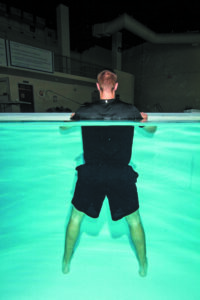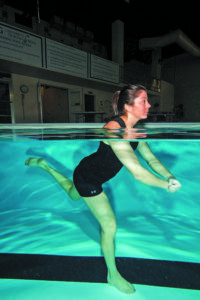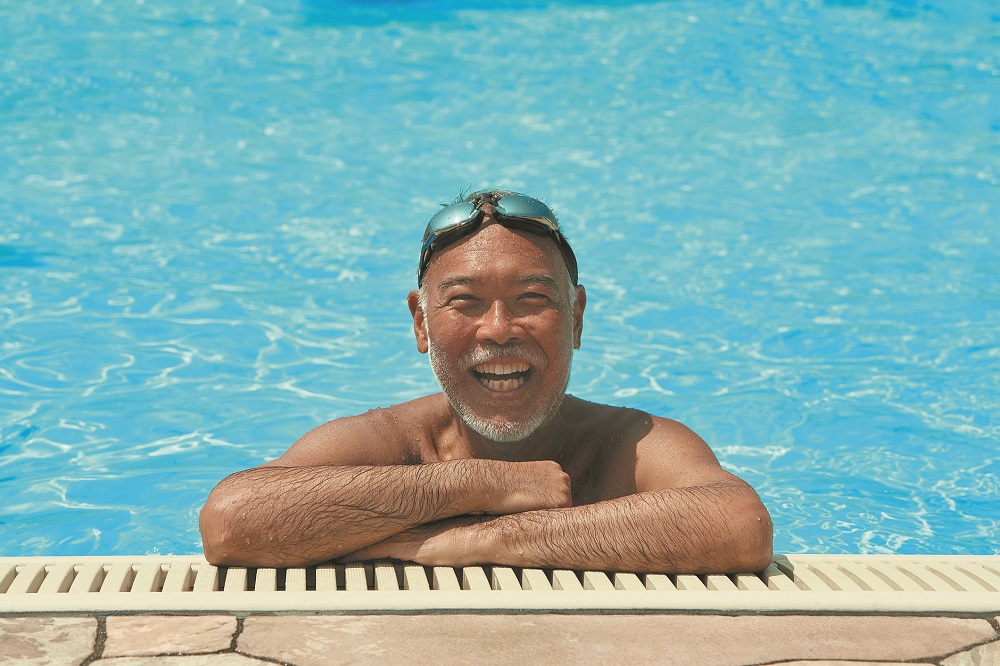Love being in a pool? Then what better way to get your exercise than by working out in a pool! Water exercise is a non-impact way to stay—or get—in shape. It’s also excellent for rehab after an injury or a joint replacement because the water cushions and supports you as you build muscle strength. In water that reaches only up to your navel, the impact on your joints is reduced by 50%…at mid-chest (the level at which most people feel comfortable, especially if they’re not strong swimmers), by 75%…at the collar bone, by 90%, and your core muscles will get a great workout because this depth makes keeping your balance more difficult. To remove all the impact, try exercising in the deep end where your feet can’t touch the bottom.
Water is a great equalizer. Compared with many other fitness environments (such as classes at a health club), the pool is a much more inclusive place mentally, socially and physically, and the typical excuses to avoid exercise fall away…
I feel uncomfortable in gym clothes. Being in water eliminates the friction of fabric against skin that many people find irritating.
I feel self-conscious. No one can see you under the water. Wear a robe to the pool, and drop it right before getting in. Instead of a swimsuit, try a bodysuit made for water or even shorts and a T-shirt.
I can’t swim. Stay near the side of the pool…and you don’t have to put your head in the water.
The basics: To find a pool, look beyond the obvious choices, such as neighborhood pools, YMCAs, aquatic or recreation centers, and health clubs. There may be a local hotel with a pool willing to give you a monthly nonguest rate.
Add-ons: In the shallow end, you can use a $1 pool noodle to increase resistance, especially for arm and shoulder exercises. Wearing webbed gloves also will give you more of an upper-body workout.
If you want to work out in the deep end or have more stability in the water, consider bringing a flotation device such as a belt (if you carry extra weight in the front, put the buckle in the front and vice versa).
On your own or with a group: Most people can follow exercise descriptions and work out on their own. But if you have any physical limitations or want the social experience of taking a class, look for a group instructor who is water-certified by the Aquatic Exercise Association or SCW Fitness Education. “Land-based” teachers don’t have the training to understand the differences between buoyancy in the water and gravity on land.
Getting Started
Warm-up and cooldown. Begin your water workout by walking back and forth across the pool from one side to the other for five to 10 minutes. At the end of each exercise session, return to water walking at a slow, relaxing pace, followed by stretches that target your quads, calves and arms.
If you’re new to exercise, start with just two or three repetitions of each of the following exercises for a total of 10 minutes every other day. As you progress, increase the reps to 12 and work out daily if you like.
Note: Many exercises begin with a bounce, also called rebounding—step down onto one or both feet as directed, slightly bend at the knee, and push off the bottom, letting buoyancy comfortably lift the body.
Exercises
Basic Jumping Jack. Focus: Inner and outer thighs, and elevating heart rate. Face the pool wall, feet together and flat on the pool bottom, hands gently holding the edge. With a small bounce or rebound, jump with both feet at the same time, and land with your feet hip-width apart. With another small bounce, jump with both feet and land with your feet back together in the beginning position. Be sure that your heels reach all the way to the pool bottom on every landing. To increase the difficulty: Move to the center of the pool, and let your arms rise at your sides, stopping just short of the water level. Keep your arms in the water at all times to avoid stress on the shoulder joints.

Criss-Cross Jumping Jacks. Focus: Muscles surrounding the shoulder joints. Stand in the middle of the pool, feet together. With your legs remaining straight, give a bounce off the pool bottom and land with your feet shoulder-width apart, arms extended straight out from the sides at a 45-degree angle with shoulders relaxed (keep arms just below the water’s surface). As you jump to bring your feet back together, let one foot cross behind the other as your arms come down in front of your body and cross at the wrists or forearms. Push off again, and return to the shoulder-width stance with arms extended out to the sides. Jump again, and bring your feet back together, but this time, cross the other foot behind and cross your arms in front with the other arm on top.

Cross-Country Skiing. Focus: Shoulder, leg and core muscles, and elevating heart rate. Stand sideways by the pool wall, and place your right foot in front of the left with your feet hip-width apart. Extend your arms with your right hand in front, touching the pool wall if needed for balance, and the left hand behind you (opposite to the position of your feet). Make a small bounce to push off the pool bottom with both feet, and reverse your leg and arm positions while off the bottom. Land on the toes of both feet at the same time, and roll down onto your heels. Repeat, reversing your leg and arm positions again, to return to start. To increase the difficulty: Let go of the wall while moving your arms and legs in opposition, keeping your core stable and upright.

Water Running. Focus: Balance and the cardiovascular system. Run back and forth from one side of pool to the other. Your feet stay close to the bottom of the pool as the leg in back passes by the leg that was in the front. The faster the pace, the less time you’ll have to lift your knees (whenever you increase the pace of an exercise, the moves decrease in size). For more of a challenge: Try serpentine running—stand in chest-deep water, and run across the pool in a zigzag pattern as though weaving through an obstacle course of cones. Turn around and repeat.

Rocking Horse. Focus: Entire body. Stand in the middle of the pool. Rebound forward onto your right foot, landing with a soft knee as you simultaneously bring your arms in front of you (as though hugging a tree), and lift your left back heel toward your glutes.With a small rebound, transfer your weight to your back foot as you open your arms to stretch your chest and your front right knee lifts to hip level (if possible). Rebound forward to your front leg, and repeat. Make sure your heels roll completely to the pool bottom on every rocking horse repetition. If the arm movements are too difficult: Bend your elbows as you rock forward, and do a biceps curl. As you rock backward, straighten your elbow joints.


Twisting Mogul. Focus: Leg and core muscles. Stand in the middle of the pool with your feet together. As you bend your knees to push off with your feet, rotate your body to the right side, and land with both feet together at a 45-degree angle. Always land on the balls of your feet, and roll all the way down onto your heels. Next, push off both feet and rotate your body to the left side, and land with both feet together at a 45-degree angle. To increase the difficulty: Pull your knees up into a tucked position after each push-off, then straighten them as you land facing the opposite side.

Deep Water Seated Core. Focus: Core, hips and triceps muscles. Hold a noodle curved around your waist, and assume a seated position with your legs extended straight out in front of you. Engage the muscles in your core and hips to maintain a right angle at your hip joints. Straighten your arms to push the noodle down into the water. Hold briefly, then relax the arms to return to start. If keeping your legs straight causes any lower back discomfort: Bend at the knee joints so that your body position resembles sitting in a straight-backed chair.




